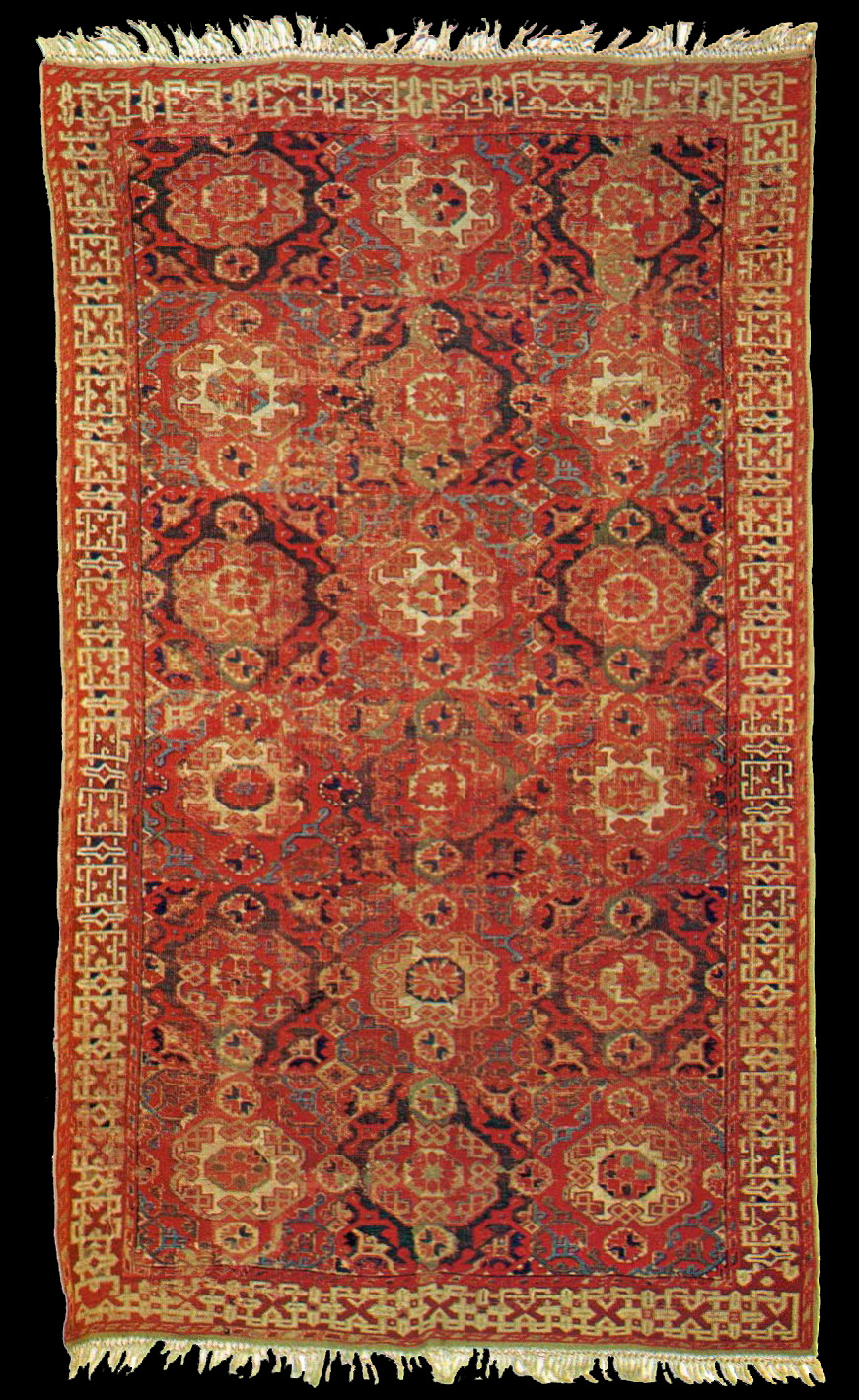A 'SMALL PATTERN HOLBEIN' RUG
WEST ANATOLIA, FIRST HALF 16TH CENTURY
Price Realized £35,850 ($57,324)
Sale Information
Christies
SALE 6715 —
ORIENTAL RUGS AND CARPETS
1 May 2003
London, King
Street
LOT NOTES
Lot Description
A 'SMALL PATTERN HOLBEIN'
RUG
West Anatolia, first half 16th century
The field with three
columns of alternating red and green panels containing octagonal hooked
panels with knotted outlines and rosette or interlace centres flanked by
smaller octagonal flowerhead panels, the large octagons divided by open
quartered lozenge medallions formed of overlapping split palmettes, in a
sang-de-boeuf stylised kufic border between light red barber-pole and
spiralling ribbon stripes, even wear and differential corrosion, some
colours repiled, small old repairs, very slight loss to outer stripe
7ft.8in. x 4ft.6in. (234cm. x 137cm.)
Provenance
Lefevre,
London, 3 February 1978, lot 7
With Dani Ghigo, Turin (per Ellis
op.cit, p.73)
Prof. Christopher Alexander, Christie's, London, 15
October 1998, lot 208
Literature
Ellis, Charles Grant: 'Ellis in
Holbeinland', in Pinner, Robert and Denny, Walter B.: Oriental Carpet and
Textile Studies I, London, 1985, p.73, no.R-60, not illustrated.
Ellis,
Charles Grant: 'On 'Holbein' and 'Lotto' Rugs, in Pinner, Robert and
Denny, Walter B.: Oriental Carpet and Textile Studies II, London, 1986,
p.171 (fig.9).
Alexander, Christopher: A Foreshadowing of 21st Century
Art, the Color and Geometry of Very Early Turkish Carpets, New York and
Oxford, 1993, pp.220-225.
Lot Notes
The 'small pattern
Holbein' design is one which is part of the international Timurid style.
Amy Briggs in her seminal article clearly demonstrated the link between
the 'small pattern Holbein' rugs and Timurid Persian arts (Briggs, A.:
"Timurid Carpets, I: Geometric Carpets", Ars Islamica 7, 1940, pp.20-54).
Links at the time between the Ottoman empire and their Timurid (and, in
the second half of the century Ak-koyunlu or White Sheep Turkman)
neighbours in Iran were strong, albeit interspersed with periods of
confrontation. Persian craftsmen for example were imported to create the
tilework for the Yesil Cami in Bursa, the then Ottoman capital in the
1420s, and again later in the century at Edirne. Thus it is not surprising
that many rugs depicted in Timurid miniatures are very similar to rugs of
the 'small pattern Holbein' group. It has also been noted a number of
times how the design of these rugs relates very closely to that of Turkman
rugs (Pinner, Robert and Franses, Michael: 'Turkish Carpets in the
Victoria and Albert Museum', Hali 24 (vol.6, no.4), p.363-5 for example).
One minor feature not mentioned there, which is common to both types in
certain examples and well represented here, is a playfulness with the
design of the centre of the medallions or guls, where in this rug there
are at least four different designs within the central octagon.
The
dating of a large number of these rugs to the 15th century is supported by
evidence from European painting. John Mills shows paintings including rugs
of this group dating from between 1451 and 1655, although the massive
concentration appears between 1450 and 1550 with only a couple of isolated
examples being shown thereafter (Mills, John: 'Small Pattern Holbein
Carpets in Western Paintings', Hali, vol.1, no.4, pp.326-334). The border
designs have been studied to form a typography by Robert Pinner and Jackie
Stanger (''Kufic' borders on 'Small Pattern Holbein' Carpets', Hali,
vol.1, no.4, pp.335-338). The present border, with its bars rather than
crosses between the kufic elements, while a variant on their type C, is
not illustrated. It appears in one other published example, a rug with two
columns of four and a half medallions in the Bardini Collection, Florence
(Viale, M. and V.: Arazzi e Tappeti Antichi, Torino, 1952, no.34, p.229
and pl.152; also Boralevi, A.: Oriental Geometries, Stefano Bardini and
the Antique Carpet, Livorno, 1999, no.12, pp.50-51.)
This rug is
included as one of the then exhaustive list of 70 known rugs and fragments
of the 'Small pattern Holbein' group by Charles Grant Ellis as no.R-60. Of
this list, excluding the numerous pieces, mostly fragmentary, in the Keir
Collection, all but 13 are held either in museums or in other institutions
or churches.
|

